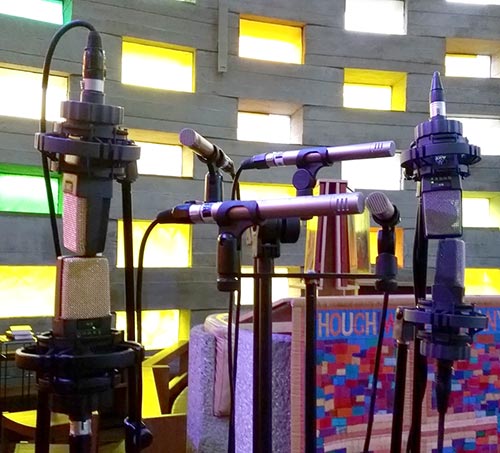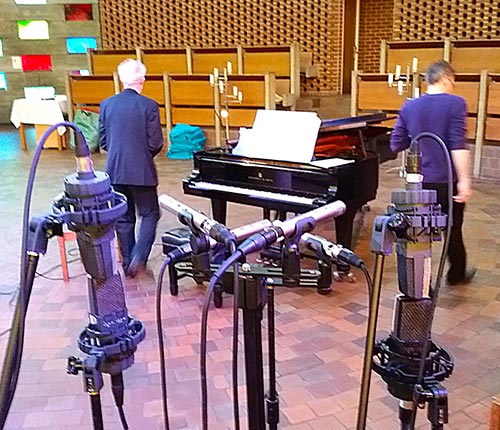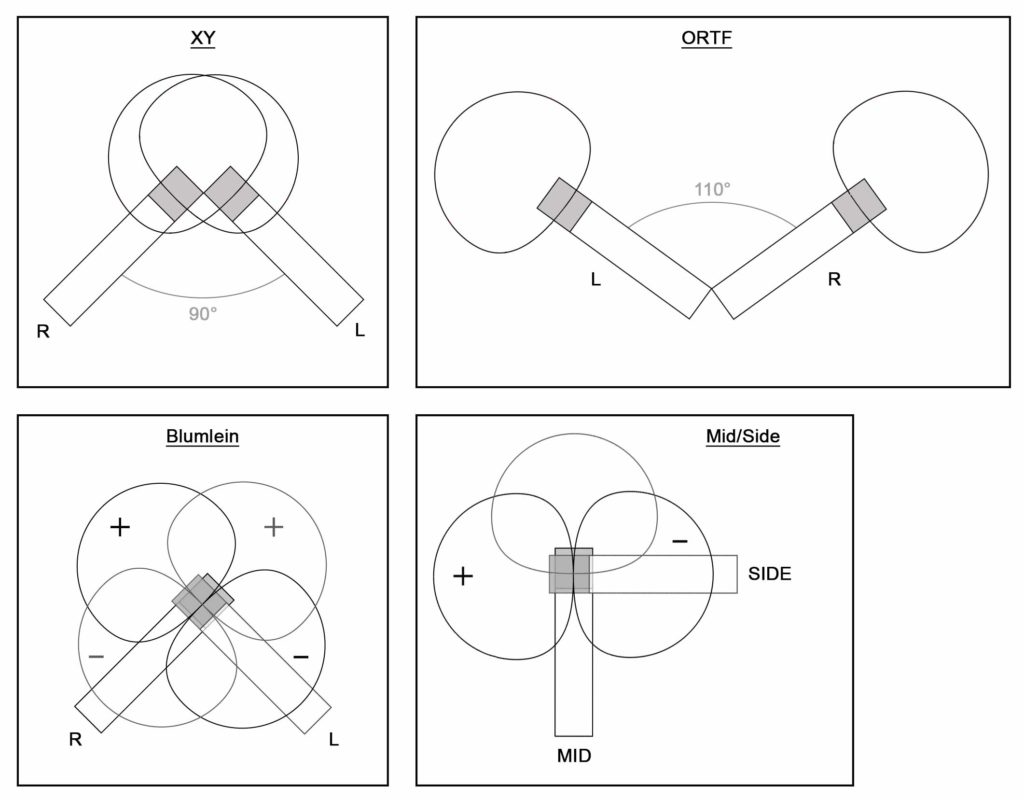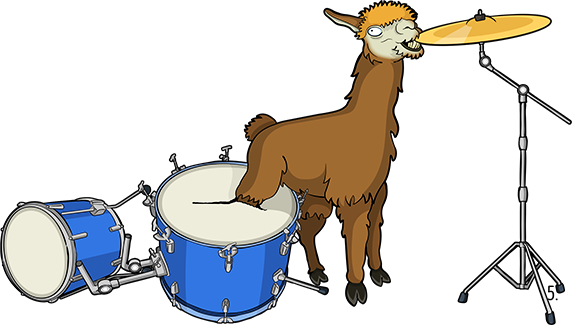Often in recording scenarios it is necessary to implement a stereo miking technique. Usually this is employed to capture room ambience at a distance from the originating sound source, by which I mean the reverberant field of an acoustic environment – anywhere where the late reflections are of greater intensity than the direct sound. Whether it’s for drum kit ambience, concert halls or choirs, ambient stereo miking provides a way of adding depth, width and general realism to the recording that is not possible through close-miking alone.
However, there are numerous stereo mic techniques and it struck me recently that I had never undertaken a direct comparison of them. This realisation in fact struck me with such vigour that I felt moved to instantly rectify the situation, spontaneously leaping up from my seat, screaming “STEREO MIC COMPARISON!!”, and bolting, arms flailing and screeching like a girl, towards the door. The other cinema-goers were somewhat bemused.
And with that I decided at once to trial four different stereo mic techniques over a few different scenarios. These are techniques that any good engineer should be aware of, but perhaps not all have actually directly compared. Well, in the name of science I hereby rise to the challenge.
Yes, that’s right… science.
So the four techniques on the menu today are the following:
- #1: XY
- #2: ORTF
- #3: Blumlein
- #4: Mid/Side
I won’t go into detail about the configuration of these techniques here, largely because it’s late and I can’t be bothered, but if you’d like to know more about their implementation, please observe the image at the top of this post, and then follow this link.
The purpose of my trials would be to answer the following questions:
- Which technique captures a more effective and balanced stereo image?
- How well does each technique collapse to mono?
- How rich is the tonal balance?
- Which one do I like best?
I chose to make these comparisons under 3 different scenarios: a large, reverberant concert hall, the drum recording environment in my studio, and with a moving sound source in a small room, which in this case was me wandering around and talking. The tests employed two sets of microphones – two AKG C414s for Blumlein and Mid/Side, and two AKG C451s for XY and ORTF. This selection was imposed due to equipment restrictions, otherwise identical microphones would have been used for all applications, thereby eliminating the variable of the sonic performance of the different mics. Nevertheless the comparisons should allow us to draw some reasonably solid conclusions.
Listed below are the recordings. Click each one to listen for yourself and see if you agree with my analysis:
Drums Collapsed to Mono – ORTF
Drums Collapsed to Mono – Blumlein
Drums Collapsed to Mono – Mid/Side


So, based upon these recordings, along with a whole load of other tests I carried out which are not listed above, here are my answers to the aforementioned questions:
- Q: Which technique captures a more effective and balanced stereo image?
- A: Mid/Side.
The weakest stereo image seemed, across the board, to be XY. It has a strong centre but very little width. This is unsurprising, since the capsules are so close together that it seems illogical to expect anything more. This is as I had always suspected, and why I never really felt tempted by this technique. The lack of movement in the voice recording is particularly noteworthy. My next preference is ORTF due to its much wider stereo image and strong centre point, followed jointly by Blumlein and M/S, both of which clearly exhibit a wide, detailed image. If I had to pick a winner, I’d go with M/S. The movement may not be quite as authentic as Blumlein, perhaps due to the trickery involved in the M/S configuration vs. the fairly organic method of Blumlein, however for the capture of room ambience for a static source, M/S just seems to have a special kind of something about it – a width and depth that to my ears is incredibly realistic.
- Q: How well does each technique collapse to mono?
- A: ORTF & Blumlein win.
The mono drum recordings reveal that no technique has any particular issue or phase weirdness occurring when collapsed to mono, however in terms of preserving the fidelity of the ambient field that we are attempting to capture, Blumlein and ORTF seem to have it over M/S and XY. With M/S this is due to the cancellation of the side mic so that we are left with only one microphone pointing at the source, and XY had the weakest stereo width anyway, so this result is unsurprising.
- How rich is the tonal balance?
- A: Mid/Side wins.
We have to be a little careful here when we start using ambiguous terms like “richness”, “warmth”, “creaminess”, “silkiness”, “moistness”, “purpleness”, etc, etc, because these aren’t exactly scientific words. However, what I intend it to mean in this instance is how well expressed are the bass, middle and treble parts of the frequency spectrum, subjectively speaking. In my view, M/S clearly trumps all others in terms of its pleasing bottom end yet detailed high frequency reproduction. This was deduced by looping small parts of the drum and concert recordings and directly comparing each technique. ORTF is also very good in this regard, followed by Blumlein and finally XY.
- Which one do I like best?
- A: Mid/Side!
Yep, it would appear that M/S is awesome. Science says so. Well, to my ears at least. My science ears. It adds something magical to the recording and is extremely pleasing to experience, especially on drum recordings when combined with the close miked signals. Here is a demonstration of that:
Drums – All Mics + M/S Ambience
Blumlein and ORTF are still excellent techniques though, offering a nice, solid centre and plenty of detailed width, which is certainly bad news for the XY technique, which has since been strapped to a rocket and jettisoned into the centre of the sun.
It deserved it, too.
That is all.





2 responses
Excellent review. I became fascinated back in 1968 when my father, a jazz guitarist, let me play with his mono Dukane reel to reel.
My favorite mic technique for large ensembles in a concert hall is the Jecklin Disk. It produces an excellent stereo image when using headphones, how most people listen these days.
Interesting. I should try it! I have done a few experiments with binaural recording, which uses the same principle. Check it out: https://youtu.be/nvYIMJTIywE?si=vPuuLGnxLX0tN5UC